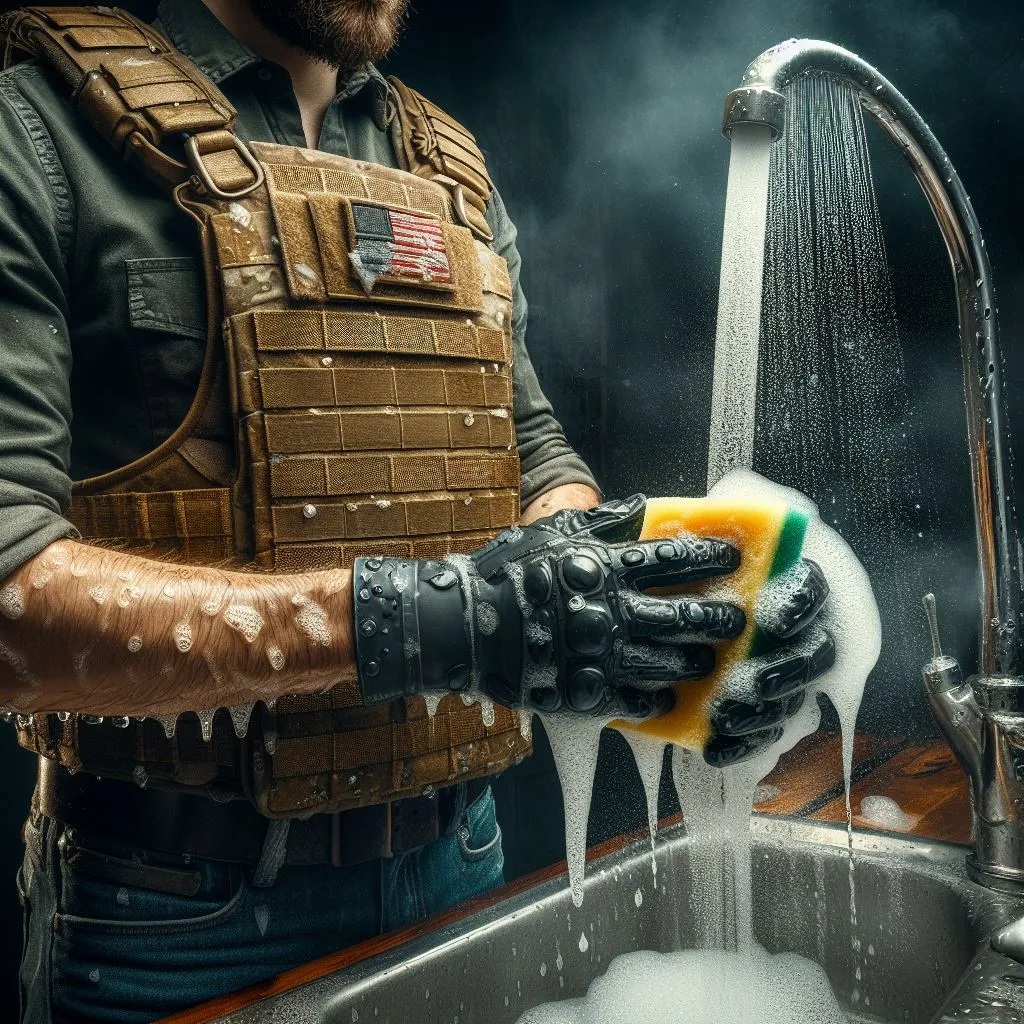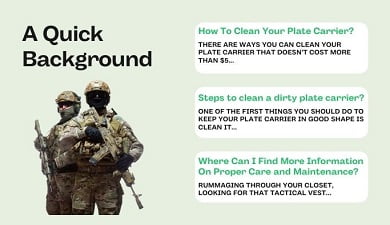If you are searching for a step-by-step guide on how to clean a plate carrier, then this post is for you. However, after extended use, plate carriers can become dirty and smelly, compromising their effectiveness. That’s why it’s important to know how to clean a plate carrier properly.

How to Clean a Plate Carrier?
Cleaning a plate carrier is not just about maintaining its appearance; it’s crucial for ensuring its longevity and functionality. Whether you’ve just returned from a muddy training session or your plate carrier has absorbed a day’s worth of sweat and grime, giving it a proper cleaning is essential. Let’s delve into the nitty-gritty of keeping your plate carrier spick and span.

Steps to Clean a Dirty Plate Carrier
- Choose the Right Detergent: When hand washing, select a mild detergent that won’t compromise the fabric or damage any specialized coatings on your plate carrier. Avoid harsh chemicals that might weaken the fabric or affect its color.
- Soak in Cold Water: Fill a basin or your sink with cold water. Submerge the plate carrier and let it soak for 15-20 minutes. This helps to loosen dirt and grime, making the cleaning process more effective.
- Gentle Scrubbing: Using a soft brush or cloth, gently scrub the entire surface of the plate carrier. Pay extra attention to seams, Velcro straps, and areas with heavy staining. Don’t forget the inside, as sweat and body oils can accumulate there.
- Rinse Thoroughly: Once scrubbing is complete, rinse the plate carrier thoroughly to remove all detergent residues. Use cold water for the rinse to help maintain the fabric’s integrity.
- Air Dry: Avoid using a dryer, as the heat can damage the fabric and any attachments on your plate carrier. Instead, hang it in a well-ventilated area to air dry. Ensure it’s completely dry before storing it to prevent mold and mildew.
Can You Wash a Plate Carrier?
The question of whether you can wash a plate carrier often perplexes many users. The answer depends on the specific design and materials used in your plate carrier. Always refer to the manufacturer’s guidelines, as some plate carriers are designed for machine washing, while others may require a more delicate touch.

If your plate carrier is machine washable, follow the guidelines provided by the manufacturer. However, for plate carriers that require hand washing, the steps outlined above will help maintain its cleanliness without compromising its structural integrity.
How to Clean Soft Armor Vests
Cleaning a soft armor vest, commonly worn under plate carriers, follows a similar process. Soft armor vests are designed to absorb and disperse impact, making them crucial for personal protection. Here’s how you can keep your soft armor vest clean:
- Check the Label: Refer to the care instructions on the label of your soft armor vest. Manufacturers often provide specific guidelines for cleaning to ensure the longevity of the protective material.
- Spot Clean as Needed: Like the plate carrier, spot clean any stains using a mild detergent and a soft brush. Be gentle to avoid compromising the integrity of the protective fibers.
- Hand Wash or Machine Wash: Similar to plate carriers, some soft armor vests may be machine washable, while others require hand washing. Follow the manufacturer’s instructions carefully to maintain the effectiveness of the protective fibers.
- Dry Properly: After cleaning, air dry the soft armor vest in a well-ventilated area. Avoid exposing it to direct sunlight, as prolonged exposure can degrade the protective fibers.
How to Store a Plate Carrier
Proper storage is as crucial as cleaning when it comes to maintaining the longevity of your plate carrier. Follow these steps to ensure your plate carrier stays in optimal condition between uses:
- Empty Pouches and Compartments: Before storing, empty all pouches and compartments of your plate carrier. This prevents any items from causing unnecessary strain on the fabric during storage.
- Inspect for Damage: Before putting your plate carrier away, inspect it for any signs of damage, wear, or loose stitching. Address any issues promptly to prevent them from worsening over time.
- Store in a Cool, Dry Place: Avoid storing your plate carrier in direct sunlight or extreme temperatures. Opt for a cool, dry place to prevent any damage to the fabric or accessories.
- Hang or Fold Properly: Depending on the design of your plate carrier, hang it on a sturdy hanger or fold it neatly. Avoid crumpling or compressing the plate carrier, as this can affect its shape and performance.
- Protect Velcro Surfaces: If your plate carrier has Velcro surfaces, consider protecting them by covering them with a soft cloth or using Velcro straps. This prevents lint, dust, or other particles from affecting the Velcro’s adhesive properties.
By following these steps for both cleaning and storage, you’ll not only keep your plate carrier in top condition but also ensure its reliability when you need it the most.
Conclusion
How to Clean a Plate Carrier? Regular cleaning and maintenance are essential for keeping your plate carrier in top condition. By following the steps outlined in this guide, you can ensure that your gear remains effective and comfortable to wear, and lasts for a long time.
FAQs About How to Clean a Plate Carrier
How often should I clean my plate carrier?
You should clean your plate carrier regularly, especially if it’s exposed to sweat, dirt, or other contaminants. Depending on usage, monthly or after every use may be appropriate.
Can I machine wash my plate carrier?
In most cases, plate carriers are not machine washable. It’s best to follow manufacturer guidelines, but generally, hand washing or spot cleaning is recommended.
How do I hand wash my plate carrier?
Fill a tub or basin with warm water and mild detergent. Submerge the plate carrier, gently scrub with a soft brush or cloth, rinse thoroughly, and air dry. Avoid excessive scrubbing to prevent damaging the fabric or attachments.
Can I remove the plates and foam padding before cleaning?
Many plate carriers allow you to remove the plates and foam padding for easier cleaning. Check the user manual or manufacturer’s instructions for guidance.
How do I clean the plates?
Plates should be wiped down with a damp cloth and mild detergent. Avoid submerging them in water, as it can damage the ballistic material.
What about the MOLLE attachments and pouches?
Remove any detachable pouches and MOLLE attachments before cleaning the plate carrier. You can clean these separately using a similar hand-washing method or as per their care instructions.
Can I use a pressure washer to clean my plate carrier?
It’s not recommended to use a pressure washer, as the high-pressure water can damage the fabric and stitching. Stick to gentler cleaning methods.
How can I remove tough stains or odors?
For stubborn stains or odors, consider using a fabric stain remover or an enzymatic cleaner. Ensure that the cleaner is safe for the material of your plate carrier.
Can I put my plate carrier in direct sunlight to dry?
Avoid prolonged exposure to direct sunlight, as it can cause fading and deterioration of the fabric and materials. Instead, air-dry it in a shaded area.






